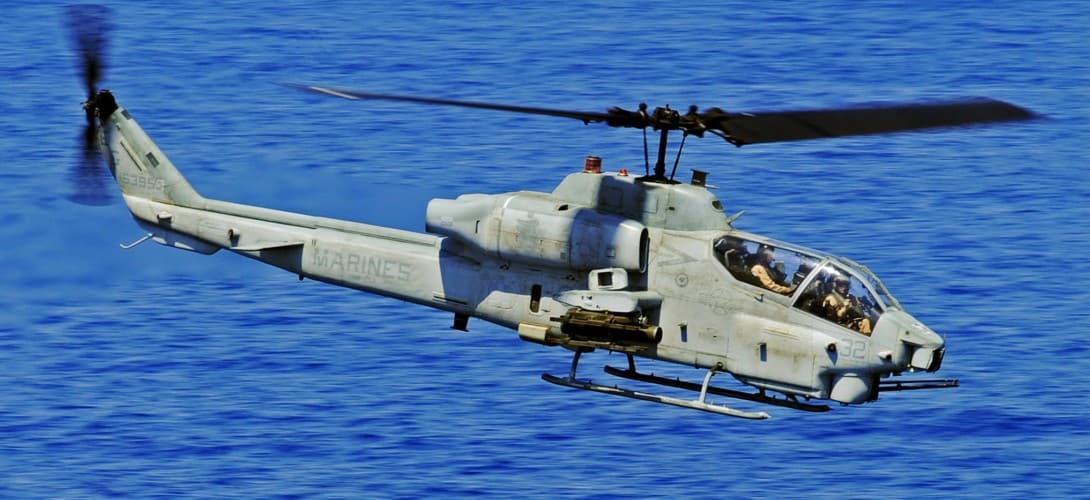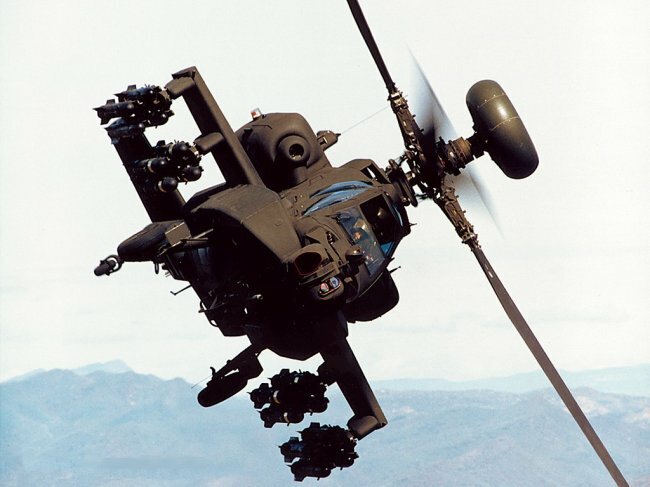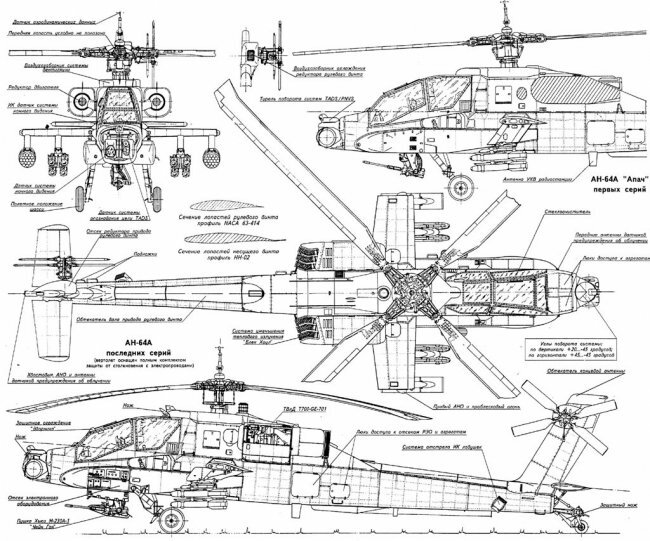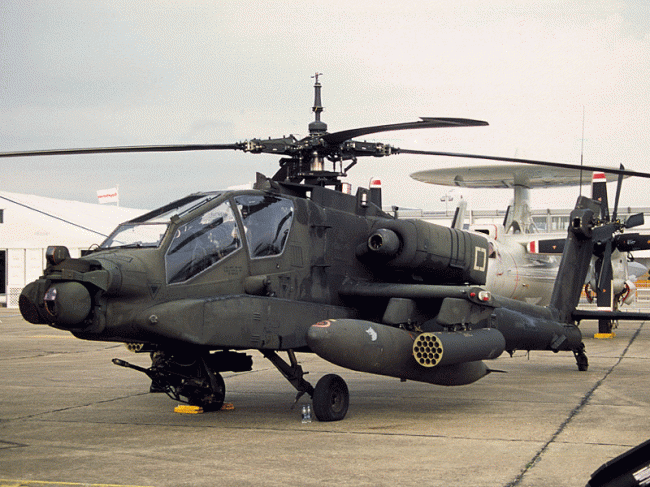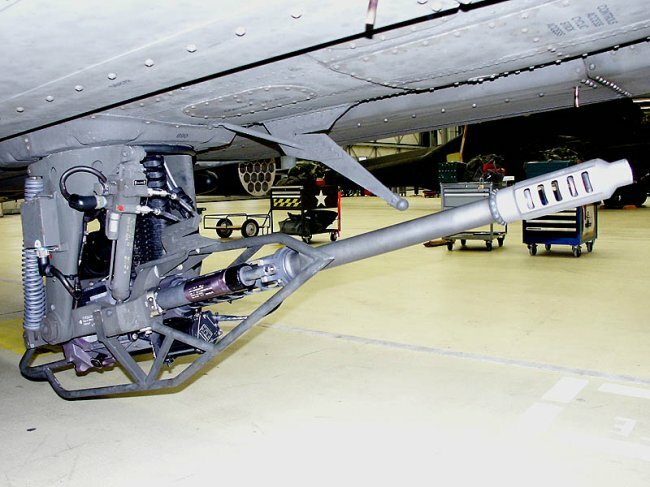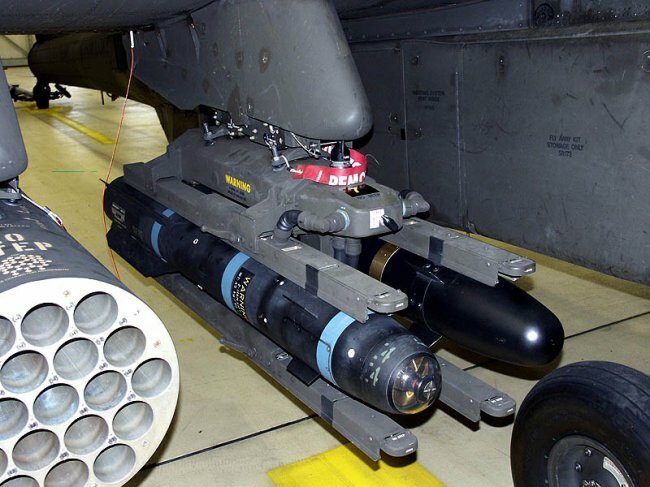аттак хеликоптер что такое
attack helicopter
1 attack helicopter
2 attack helicopter
3 attack helicopter
4 attack helicopter
5 attack helicopter
6 attack helicopter
7 attack helicopter
8 attack helicopter
9 ATK HELO
См. также в других словарях:
Attack helicopter — An attack helicopter, also known as a helicopter gunship, is a Military helicopter armed for attacking targets on the ground such as enemy infantry, armored vehicles and structures, using autocannon and machine gun fire, rockets, and precision… … Wikipedia
attack helicopter — atakos sraigtasparnis statusas T sritis Gynyba apibrėžtis Sraigtasparnis, sukonstruotas taip, kad būtų galima naudoti įvairius ginklus priešo taikiniams pulti ir naikinti. atitikmenys: angl. attack helicopter pranc. hélicoptère d’attaque … NATO terminų aiškinamasis žodynas
attack helicopter — A helicopter specifically designed to employ various weapons to attack and destroy enemy targets … Military dictionary
attack helicopter — combat helicopter, type of helicopter used to conduct air attacks in war … English contemporary dictionary
Denel AH-2 Rooivalk Attack Helicopter — Denel AH 2 Rooivalk … Deutsch Wikipedia
Twin Cobra: Desert Attack Helicopter — Twin Cobra Twin Cobra Éditeur Taito, Romstar Développeur Toaplan Concepteur Tatsuya Uemura (compositeur) Date de sortie Borne d arcade … Wikipédia en Français
Helicopter — For other uses, see Helicopter (disambiguation). Helicopter An LAPD Bell 206 … Wikipedia
attack — I. verb Etymology: Middle French attaquer, from Old Italian *estaccare to attach, from stacca stake, of Germanic origin; akin to Old English staca Date: 1562 transitive verb 1. to set upon or work against forcefully 2. to assail with unfriendly… … New Collegiate Dictionary
Helicopter flight controls — Location of flight controls in a helicopter A helicopter pilot manipulates the helicopter flight controls in order to achieve controlled aerodynamic flight.[1] The changes made to … Wikipedia
Helicopter Shark — is a composition of two photographs that gives the impression that a Great White shark is leaping out of the water attacking military personnel climbing a suspended ladder attached to a special forces UH 60 Black Hawk helicopter. The photo was… … Wikipedia
The 15 Best Attack Helicopters in the World
From Creedence Clearwater Revival’s “Fortunate Son” in Forrest Gump to Wagner’s “Ride of the Valkyries” in Apocalypse Now, the sight, sound, and yes, “smell of napalm in the morning” have made attack helicopters iconic images of modern warfare.
History of Attack Helicopters
Attack helicopters trace their roots back to World War II—long before helicopters were successful. During the war, pilots demonstrated that small, slow aircraft could be used successfully against ground troops and tanks.
Most notably, the US Army used the Piper Cub’s military version, the L-4, armed with as many as six bazookas. They showed great potential for destroying enemy tanks and clearing the way for ground forces.
While those Piper Cubs were a long way from today’s advanced helicopters, they did have similar performance profiles. After all, attack helicopters are generally small and slow compared to many other types of military airplanes. However, that’s their advantage–they are easy to hide and can pop up out of nowhere to take the enemy by surprise.
As helicopters advanced in technology, so too did their armaments and missions. Helicopters saw extensive use in Korea and Vietnam. Like that Piper Cub drafted into military service, early helicopters were modified civilian models armed and made ready for war. The first ground-up design of an attack helicopter was the AH-1 Cobra, made by Bell Helicopters.
Development and History of the Attack Helicopter
The Different Types of Attack Helicopters
Today’s best attack helicopters are mission-specific gunships. The key to making these flying machines viable for an army or air force is emphasizing their multi-role capabilities. Of the many missions that light to medium-duty helicopters can perform, they can:
Naming Attack Helicopters
What’s in a name? A lot of that has to do with Vietnam, of course, where attack and medivac helicopters played a key role.
A proud part of that history has been a tradition of attack helicopters using Native American names. This is due to the Bureau of Indian Affairs and General Hamilton Howze, who felt the speed and agility of these helicopters were a fitting tribute to the Sioux Indian tribes’ famously-swift warriors.
The first six helicopters on this list do that, and they account for some of the most recognizable aircraft names – “Apache,” “Comanche,” “Black Hawk” – in the US Armed Forces.
The other prominent naming theme on this list is the litany of Bell helicopters. The Texas company has been responsible for many of the most iconic models that would show up in films such as Forrest Gump, Apocalypse Now, and M*A*S*H.
Another quick M*A*S*H/Bell note – despite the 1970 film and classic 1970s series being set during the Korean War – a miniature Bell UH-1 Iroquois model can be seen despite the fact that model was built and used later in the Vietnam War.
So without further ado, let’s take a look at the best and most iconic US attack helicopters of all-time.
Best US Attack Helicopters
1. Boeing AH-64 Apache (USA)
The Apache is arguably the most successful attack helicopter of all time. After all, it is most likely the first make and model that comes to mind when discussing this type of aircraft. While aerospace giant Boeing currently builds it, the design was made by Hughes Aircraft, which was bought out by McDonnell-Douglas, which later merged with Boeing.
The Apache AH-64D has seen extensive use over the past three decades, from attacks on Iraq’s radar system during the Gulf War and later operations in Iraq and Afghanistan to NATO intervention in Bosnia and Kosovo to Israeli action in Lebanon and Israeli action against Hamas and Hezbollah.
It first flew in 1975, but it wasn’t until 1986 that it was introduced into service. Today, Apaches fly for many air forces around the globe. The primary operators are the US Army and the Israeli, Egyptian, and Royal Netherlands air forces. Over 2,500 Apaches have been made. AugustaWestland has built the type under a license agreement in England for British forces.
It is a twin-engine attack helicopter with armor-piercing armaments, including an M230 30-mm cannon, Hydra-70 2.75-inch rockets, and laser-guided Hellfire missiles with a rate of fire of 600 to 650 rounds per minute. It has a combat speed of 166 mph, top speed of 188 mph, range of 260 mi, and gross weight of 26,260 lbs.
The Apache is a two-crew member helo. The crew sits in tandem, one in front of the other. Both stations have full flight and weapon controls for redundancy. It’s a multi-role chopper designed with versatility in mind.
The current version of the aircraft is the Boeing AH-64E Apache. It has a 48-foot (14.63 m) diameter rotor system, a mission weight of 15,075 pounds (6,838 kg), and a max gross weight of 23,000 pounds (10,432 kg). With a 150 knot or more top cruising speed, climb rate of 2,800+ ft. (853+ m) per minute and a service ceiling of 20,000 feet, there aren’t too many missions that the Apache doesn’t excel in.
2. Black Hawk Utility Helicopter UH/HH-60
The Black Hawk is famous in part for Black Hawk Down, the 2001 Oscar-winning Ridley Scott film based on the 1999 book on the downing of a US Black Hawk during the Somali Civil War. The incident may have helped cause the Clinton administration’s non-intervention during the Rwandan Genocide.
Despite the incident, the Black Hawk is viewed as a fast and effective way to transport soldiers across the battlefield. A single Black Hawk helicopter can house a crew of up to 11 infantry and crew members at 182 mph, faster than most other helicopters.
Twin GE-700 engines power the Black Hawk to those speeds. It can support an external load of 8,000 lbs and internal load of 2,640 lbs, and gross weight of 20,250 lbs. It boasts a crew of two pilots, two crew chiefs, and is armed with two 7.62 mm machine guns.
3. Cheyenne Attack Helicopter AH-56
Not all helicopters live to see a long service history. The Cheyenne AH-56 was developed in the mid-60s, but it only ever saw 10 prototype attack helicopters before the program was cancelled in 1972. Derailing the program? Crashes, costs, the Key West Agreement, and the Vietnam War winding down.
Its status as an aviation “What If?” lingers for helicopter enthusiasts, however, as the Cheyenne AH-56 was quite impressive for its day. At 54 ft long and with a cruising speed of 224 mph and a top speed of 244 mph, it was longer and faster than many helicopters of the era.
The Cheyenne AH-56 still served as an inspiration to future helicopters, especially as the A-10 Thunderbolt. The technologies that were developed for the Cheyenne AH-56 also saw later use in other capacities.
4. Kaman SH-2 Seasprite/H-2 Tomahawk
The split name here derives from the fact that the Tomahawk was intended to be an Army version of the Seasprite, which was employed by the Navy in the early 60s. However, while at least 200 Seasprites were produced, the Tomahawk, like the Cheyenne, only saw a few units made.
The original need for both the Seasprite and Tomahawk came from the desire for multi-role helicopters that could operate in all types of weather conditions. Its main use came not during the Vietnam War but the Gulf War and in naval standoffs with Iran.
It housed a crew of three, measured 38 ft 4 in. x 13 ft 7 in., had a cruising speed of 149 mph and top speed of 164 mph, an operational range of 367 mi, and could be armed with AGM-65 Maverick and anti-ship missiles as well as 2xMK50 ASW torpedoes.
5. Bell H-13 Sioux
While not an attack helicopter per se, the Bell H-13 set the stage for later Bell models and several attack helicopters. Its most famous depiction by far being its repeated usage on M*A*S*H.
The H-13 was a three-seat helicopter featuring a soap bubble canopy, saddle fuel tanks, and other features designed to allow the helicopter to be swift, lightweight, and maneuverable, and could return fire with twin mounted machine guns.
It measured 31 ft 7 in. x 9 ft 8 in. and a gross weight of 2,952 lb, and could reach a top speed of 105 mph, with a typical cruising speed of 84 mph, a service range of 273 mi, and a service ceiling of 16,100 ft.
To achieve that speed, the H-13 used 1 × Lycoming TVO-435-A1A six-cylinder with a horizontally opposed piston. It is capable of 260 hp, with the main rotor diameter measuring 37 ft.
6. Bell UH-1 Iroquois
Chances are you know this as the “Huey.” It was originally designated as HU-1, hence the nickname. An icon of the Vietnam War, it saw extensive service combating the Easter Offensive in 1972. Seven thousand thirteen UH-1s were deployed in Vietnam, of which 3,305 were destroyed, with more than 2,800 fatalities.
The Huey has been produced for militaries all over the world, and has thus seen action ranging from the Falklands War between Britain and Argentina to Japan deploying Hueys to Pakistan for disaster relief and using two Hueys for coastal surveillance during the 2011 Fukushima Nuclear Disaster.
Hueys had a weight capacity of 3,880 lbs, measured 57 ft 1 in. x 8 ft 7 in., could handle a gross weight of 9,040 lbs, enjoyed a cruising speed of 125 mph and maximum speed of 135 mph, had a range of 315 mi, and could be armed with 7.62 mm machine guns and 2.75 in. rocket pods.
7. Bell AH-1G Cobra
Before the Apache became one of the most widely-produced and used attack helicopters in history, the Bell AH-1G Cobra was the backbone of the US helicopter forces, was used in Vietnam and the Gulf War, and remains a classic example of the aircraft type today.
The Cobra started life as an attack helicopter variant of the famous Vietnam-era Huey. The Huey was a medium-sized troop-carrying helicopter that proved its worth countless time in the jungles of Vietnam. The Cobra used it’s rotors, tail, and engine but made modifications on the airframe to reduce bulk and keep it maneuverable.
The Cobra first flew in 1965 and went into service with the US Army in 1967. The AH-1G Cobra has been retired, but it was replaced by an upgraded twin-engine version, the AH-1W SuperCobra. The SuperCobra’s twin engines were made at the Marine Corps’ request, who wanted better over-water safety.
Israel likewise maintained a fleet of Cobras, which saw use in some of its wars with Lebanon. In 2015, Israel leased retired Cobras to Jordan to help them keep Islamic State at bay.
All Cobras appear nearly identical. They feature a crew of two, seated in tandem. The aircraft have stub wings on the side of the fuselage for mounting weapon payloads or external fuel tanks.
Cobras have a crew of one pilot and one gunner, measured 53 ft x 10 ft 4in., can support 9,500 lbs, can achieve a maximum speed of 171 mph, have an operational range of 310 mi and can be armed with 2×7.62 mm multi-barrel Miniguns, 2×M129 40 mm grenade launchers, 2.75 in. rockets, or M18 7.62 mm Minigun pods.
8. Bell AH-1 SuperCobra
An updated version of Bell’s classic Cobra, this attack helicopter was developed toward the end of the Vietnam War. They saw use in the invasion of Grenada, the Gulf War, and the Iraq War, where dozens sustained damage, mainly from ground units. US SuperCobras were retired in 2020.
Some of the most extensive use of SuperCobras in combat, however, came during the aforementioned Iraq-Iran War. They were frequently used as anti-armor vehicles to great effect. In 2016, Kurdish PKK militants shot down a Turkish SuperCobra with a surface-to-air 9K38 Igla missile launcher.
SuperCobras feature a two-person crew, they measure 45 ft x 9 in. x 10 ft 9 in., have a max takeoff weight of 10,000 lbs, can achieve a maximum speed of 175 mph, and can be armed with, among other armaments, 20 mm M197 3-barreled Gatling cannons, 2.75 in. rockets, 5 in. Zuni rockets, and AIM-9 Sidewinder anti-aircraft missiles.
9. Bell AH-1Z Viper
The latest in Bell’s long line of attack helicopters, the Viper is designed to replace the SuperCobra. It was approved for full production and declared combat-ready by the US Marine Corp in 2010.
In 2015, the United States okayed the sale of Vipers to Pakistan. The Polish, Czech, Romanian, Moroccan, and Bahraini Armed Forces have all purchased or expressed interest in purchasing Vipers.
The venerable aircraft has received a new four-blade, composite-construction rotor system and an upgraded next-generation targeting system. The AH-1Z was introduced in 2010 and flies for the US Marine Corps. Of course, there are upgraded avionics and weapons systems as well.
The Cobra benefitted from the USMC’s H-1 upgrade program. The AH-1Z and the UH-1Y share many common components, which reduce the Corps’ overall maintenance and parts costs. Over 84% of all the components of the two aircraft are identical.
The Vipers feature two-person crews, they measure 58 ft 3 in. long, have a max takeoff weight of 18,500 lbs, a cruising speed of 180 mph, combat range of 125 mi, and can be armed with, among other armaments, a single 20 mm M197 three-barreled rotary cannon, 2.75 in. rockets, and AIM-9 Sidewinder and AGM-114 Hellfire air-to-surface missiles.
Best Russian Attack Helicopters
10. Kamov Ka-50 Black Shark
The Ka-50 was designed in the 1980s as a single-seat attack helicopter and scout. It has a unique dual rotor configuration that makes this striking craft particularly noteworthy. It was also the world’s first helicopter with an ejection seat. It went into service in 1995 for the Russian Air Force.
The two-seat variant, the Kamov Ka-52 “Alligator,” is also known as the Hokum B (the Ka-50 is known as the “Hokum A”). While the airframe was designed in the mid-1990s, it didn’t become popular until 2010.
In 2015, Egypt purchased 46 Ka-52 “Nile Crocodiles.” Kamov modified these export models to deal with the severe climate in Northern Africa, with new cooling systems and heavy-duty landing gear.
There are many other variants of these powerful gunships too. There’s a folding-blade version for the Russian Navy and many special export versions. All of them share the same high-performance combat capabilities, excelling at air-to-air combat and defeating heavily-armored tanks.
11. Mil Mi-24 Hind
The Russian-built Mil Mi-24 has been around for a while. It first flew in 1969, and the Russians began working on an attack helicopter concept after watching the American success with the Cobra in the Vietnam conflict.
The Hind is a large gunship that doubles as a troop carrier. It has room for eight passengers in its hold and numerous weapons on its outer wings. They are heavily armored and can resist half-inch rounds from all angles, including the rotor blades, which are made of titanium.
The Mi-24 was initially conceived as an attack helicopter, but in practice, it is more similar to a UH-1 Huey gunship. It can carry troops and still pack a punch, but it’s unlike anything the Western Armies fly. The Mi-24 is worthy of the list, though, because its multi-role support options have made it popular worldwide. Mi-24 is used by the Russian Air Force and 58 other users around the globe. Over 2,600 airframes have been built.
12. Mil Mi-28 Havoc
First flown in 1988, the Mi-28 is the replacement for the venerable Mi-24. But unlike its predecessor, the Havoc is intended as an anti-armor attack helicopter. The lack of the bulky passenger area gives the Havoc greater speed and maneuverability, making it a deadlier attack helicopter.
Funding and design problems meant that the Mi-28 program had many stops and starts over the years. The Russian Ka-50 was a successful attack helicopter already in production, so the benefit of the Mi-28 was hard to justify. But after the Cold War ended, the idea of having an attack helicopter with more commonality to the Mi-24 Hind became appealing.
The program began to take off in the 2000s. Several variants of the design were built, including those made specifically for export.
Best European Attack Helicopters
13. Airbus/Eurocopter Tiger (EU)
The Eurocopter Tiger went into service in 2003, before the chopper manufacturer merged with Airbus. The project had been in development for decades; its original mission was to be an anti-tank gunship to guard against a Soviet land invasion. When the Soviet Union collapsed in 1991, Germany and France continued with the project and made the Tiger a multi-mission capable helo.
The Tiger was the first all-composite helicopter designed in Europe, and it’s exceptionally maneuverable and packed with advanced technologies. It’s stealth, has a glass cockpit, and can carry payloads of various weaponry. The primary operators include the German, French, Spanish, and Australian Army. If you think these two-crew member choppers have limited capabilities, read this harrowing account of the heroic actions of a Tiger crew who rescued three crewmembers from a downed Gazelle in Mali.
14. Agusta/Westland A129 Mangusta (Italy)
First flown in 1983, the Mangusta is in many ways the precursor to the Eurocopter Tiger. The craft is still in service today with the Italian Army. Turkey has taken the design and modified it into the TAI/AgustaWestland T129 ATAK for their army.
The A129’s original mission was light observation and anti-tank. It was initially begun as a joint venture between Italy and West Germany. While that partnership eventually faded into history, Agusta successfully designed the craft to be a marketable competitor to the US-built Apache on the international market. The final designs of the A129 are true multi-mission capable choppers, depending on their armaments. They can be used for armed reconnaissance, ground attack, fire support, anti-armor, or anti-aircraft missions.
Much of the airframe and components designed for the A129 come from the popular Agusta A109 civilian helicopter. Upgraded versions include the A129 International version, with upgraded LHTEC T800 turboshaft engines and a five-blade rotor system, A129 CBT upgraded version for the Italian Army, and the T129 for the Turkish Army. The successor for the A129, the AW249, is currently under development by Leonardo Company.
Best Chinese Attack Helicopter
15. CAIC WZ-10 Fierce Thunderbolt
When China needed an attack helicopter for the People’s Liberation Army Ground Force, they partnered with Russia’s premier helicopter designers at Kamov. The collaboration eventually fell apart over different design philosophies, and the Chinese took the project on their own. The final product was developed by Changhe Aircraft Industries Corporation (CAIC) and built in China.
The WZ-10 first flew in 2003 and is in service now. It has a host of cutting edge technologies onboard, including an awe-inspiring electronics warfare package. Like many attack helicopters, the WZ-10’s primary mission is anti-tank warfare, but it is very capable in air-to-air combat as well.
Also of note is the smaller and lighter Chinese Harbin Z-19. Known as the Black Whirlwind, this light attack helicopter is the WZ-10’s little brother.
AH-64 Apache Attack Helicopter
AH-64 Apache является первым армейским боевым вертолетом, разработанным с целью взаимодействия с наземными войсками на переднем крае, а также для противотанковых операций в любое время суток, в условиях плохой видимости и в сложных метеорологических условиях при большой степени сохранения боеспособности, живучести и возвращения в строй. Вертолет «Апач» проектировался исключительно для ведения наступательных операций при максимальной внезапности действий (исходя из принципа «вести бой и выжить»). Тактико-технические требования армии для вертолета AH-64A «Апач» с вооружением из 8 ПТУР «Нелфайр» и 320 30-мм снарядов включали вертикальную скороподъемность 2,3 м/с на высоте 1220 м при температуре 35°С, крейсерскую скорость 269 км/ч на высоте 1220 м и продолжительность полета при выполнении типового задания 1 ч 50 мин.
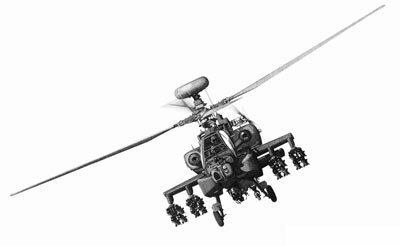
Система TADS объединяет пять подсистем, которые позволяют в любое время суток и в сложных погодных условиях за считанные секунды обнаруживать и опознавать цели, с высокой точностью определять их дальность и координаты. Система TADS включает в себя следующие подсистемы: лазерный дальномер-целеуказатель (LRF/D); ИК-система ночного видения в передней полусфере (FLIR); оптическая система прямого видения (DVO); телевизионная система отображения в дневное время (DT); лазерный блок слежения. Все это оборудование размещается в бочкообразном обтекателе в носовой части вертолета. Подсистемы передают сигналы для отображения на лобовом стекле летчика и оператора.
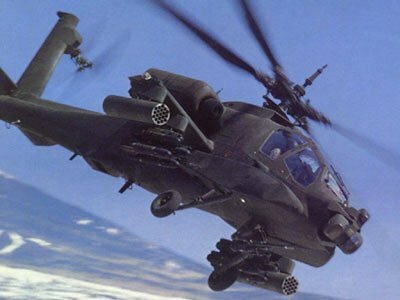
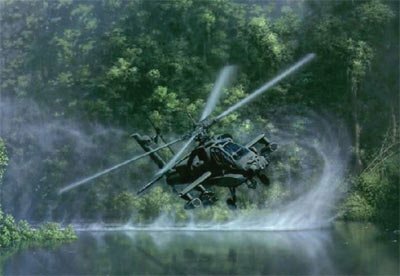
Система крепления лопасти отражает опыт фирмы «Хьюз», накопленный при разработке легкого вертолета OH-6A, где использованы система упругих пластин-торсионов с эластомерными демпферами в плоскости вращения и разнесенными горизонтальными шарнирами. Лопасти несущего винта имеют профиль HH-02. Рулевой винт установлен с левой стороны стреловидного киля. Он состоит из двух двухлопастных винтов, установленных по Х-образной схеме, при которой лопасти расположены под углами 55 и 125° друг к другу, что обеспечивает оптимальное снижние уровня шума. В лопастях рулевого винта использован профиль NACA 64A006. Двигатели вертолета размещены в гондолах по бокам фюзеляжа. Такой значительный разнос двигателей является мерой предотвращения выхода из строя обоих двигателей при одиночном выстреле по вертолету.
Опытные вертолеты были оснащены ТВД «Дженерал Электрик» YT700 или T700-GE-700 (номинальная мощность двигатля 1560 л.с.). Фирма «Дженерал Электрик» подготовила более мощный вариант под обозначением T700-GE-401 (обозначение для армии T700-GE-701) в соответствии с требованиями флота США к противолодочному вертолету Сикорский SH-60B «Си Хоук». В 1983 году фирма «Дженерал Электрик» поставила армии первые серийные ТВД T700-GE-701 для установки на вертолеты «Апач». Новые вертолеты AH-64D оснащены модифицированными двигателями T700-GE-701C повышенной мощности. Двигатели имеют модульную конструкцию и снабжены встроенными центробежными воздухоочистителями (пылезащитными устройствами), которые обеспечивают удаление до 95% пыли и песка, засасываемых в воздухозаборник.
Выхлопные устройства двигателей оборудованы системой «Black Hole», снижающей тепловое излучение. Общая емкость двух протектированных топливных баков составляет около 1 420 литров. Трансмиссия включает главный и промежуточный редукторы, редукторы рулевого винта и двигателей, соединительные валы. Мощность двигателей, имеющих встроенные редукторы, передается на главный редуктор и через вал привода рулевого винта на рулевой винт. Промежуточный редуктор и редуктор привода рулевого винта работают на консистентной смазке, чтобы уменьшить опасность выхода из строя от действия пуль и осколков. При израсходовании или вытекании смазочного масла главный редуктор в течение 1 часа может работать без смазки. Поставки элементов трансмиссии осуществляют фирмы «Литтон» и «Эркрафт Гир».
Темп стрельбы этой пушки 625 выстрелов в минуту, эффективная дальность стрельбы по наземным целям 3 000 м. Для борьбы с танками вертолет вооружен ПТУР «Хеллфайр» с полуактивной лазерной головкой самонаведения. На четырех подкрыловых узлах подвески могут размещаться до 16 таких ракет. При необходимости на каждом из узлов подвески вместо ПТУР может размещаться также по одной пусковой установке, в каждой из которых находится 19 неуправляемых авиационных ракет калибром 70 мм.
Разработаны следующие модификации вертолета:
